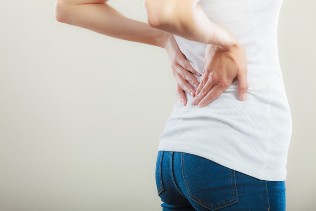It is believed that this disease is not treatable and goes away. But actually, things can be much more difficult. What could be the causes for pain in the back and some of them need medical care?

Muscle load
Approximately 85% of cases of chronic or occasional back pain associated with excessive stress. Don't be surprised: even if you do not exercise, do not carry heavy things and dig in the beds day and night, the muscles of the back, still have daily strain. When you sit, for example, in front of the monitor, preserving the majority of the body. Therefore, doctors recommend that those who do the work on the table, as it can be "deeper" to sit on a chair, leaning on the back.
However, the diagnosis of "tired back" no one is going to bring. As a rule, mild back pain attributed to "undetermined causes" (this may be a temporary damage to the muscles or ligaments) and treated with rest and proper posture in the chair. If pain does not disappear after 2 weeks or repeat regularly, ask your doctor to do a more detailed review.
Compression fracture
According to the American medical Association, the diagnosis is about 4% of patients with pain in the back. Compression fracture — fracture in a vertebra, most frequently in the elderly and osteoporotic patients. In this disease bones become less dense and can break easily under the pressure of body weight. Therefore, fractures as a result of injuries in this category are not included. So the patient himself can not see how you break your vertebra to talk about this, to be just a sharp annoying pain.
Such fractures are treated with a strict bed routine and medications to reduce pain.
Herniated discs
A herniated disk — a fairly common problem that often occur in people over 40 (although can be diagnosed at an earlier age). Cause — degeneration of muscle and connective tissue. With age, your spine, as if the "rescue" of the vertebrae are pressed closer to one another, the intervertebral discs are flattened and bulge beyond the vertebral column. The result is the same compression of the nerve roots, causing sharp pain in the lower back and legs.
As a rule, the localization of pain may tell the doctor where there may be a hernia. However, to confirm the diagnosis and accurately determine the location of the hernia is usually performed with magnetic resonance imaging (MRI).
Spondylolisthesis
This condition occurs in 5-7% of the population, although it is reported much less often (most often for chronic kidney pain, people just do not pay attention). Spondylolisthesis at the foot of one vertebra (usually the 5 lumbar) is deformed, causing the bell "crawls" at the bottom, and bulging at the same forward or backward. The relevant part of the spine becomes like a ladder and not stick.
The symptoms are the same — pain in the lower back, sometimes in the buttocks, can be only listed in the lower extremities. Misaligned vertebrae can compress nerve roots extending from the spinal cord, leading to pain.
Ankylosing Spondylitis
Another name for this disease — ankylosing spondylitis. The most common in men, both older and younger people. Women make up less than one sixth of all patients.

Primarily manifested by pain and stiffness in the lower back pain pain in hips, constant tension of the back muscles. The reason is the inflammation of the joints and ligaments of the spine. This is a chronic progressive disease, that is, while keeping the lumbar spine, the inflammation extends to the neck and chest. Even more, over time, can affect the connective tissue of internal organs, cardiovascular system, kidney, lung and also eyes. However, the disease is quite rare — it "set" for around 0.35 of the patients.
Cancer
Approximately 0.7% of patients complaining of back pain later detected cancer. It could be cancer, initially localized in the spine, or tumors metastatic from other organs. As can be seen from the statistics, such cases are very rare: generally cancer is "caught" with other symptoms, and if you don't have oncological diseases earlier, back pain is hardly portends you this scary diagnosis.
Inflammation of the spine
One of the rare causes of back pain (0,01%). Typically, the infection begins with the spine, and comes to the waist through the bloodstream from other parts of the body from the urinary channel, for example. Like other infectious lesions, usually accompanied by fever. However, a combination of "back pain + fever", does not mean that you are infected spine. The flu, for example, can cause the same symptoms.



























